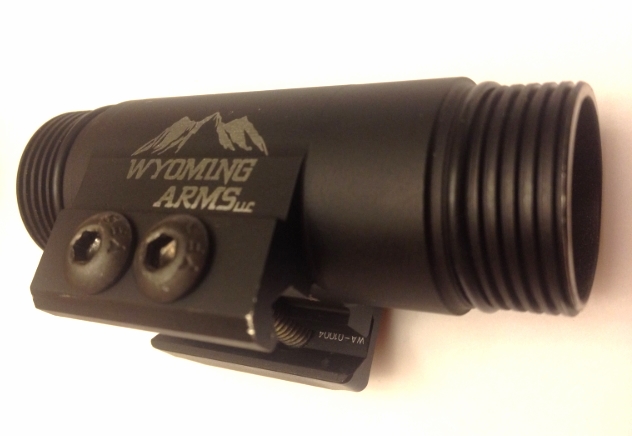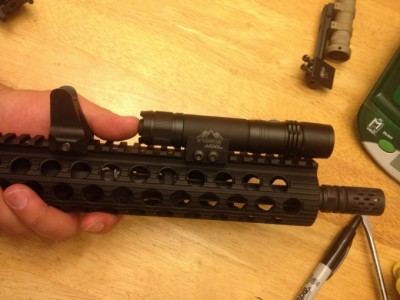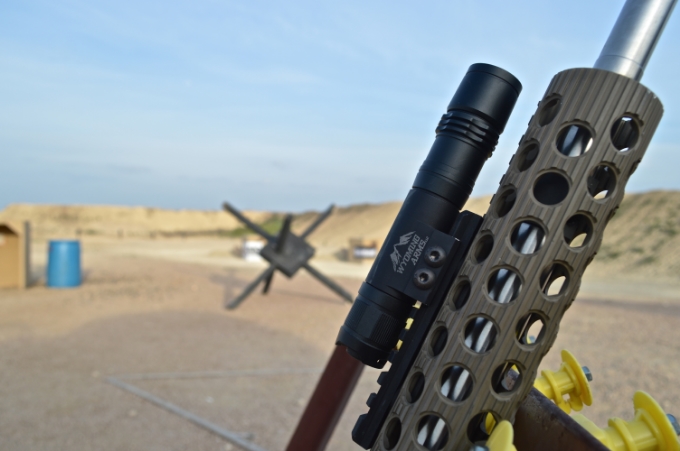
With the advances that are being made with LED technology in recent years handheld flashlights and weapon mounted lights have been getting smaller, brighter and cheaper. In fact, it seems like the advances are happening at the speed of…well, nevermind…
I recently had the chance to review a new weapon mounted light from John Burns at Wyoming Arms. You might recognize John’s name from the Beyond Belief long range hunting videos and the Best Of The West cable series. At Wyoming Arms, John is now building AR-15s and by all accounts is doing a great job at it.
Another product that Wyoming Arms is producing is a weapon mounted light based on the popular Fenix PD35. Although not well known as weapon mounted lights, Fenix’s lights are very popular among those looking for high lumen, low cost handheld flashlights. Wyoming Arms has come up with an ingenious mounting solution for the Fenix PD35 light that replaces the body of the light with an integral picatinny mount. The integral mount keeps the light very low profile and ensures that the light won’t every “shoot loose” from it’s mount. I have a 15″ free float rail on my patrol rifle and I found that if I moved the fixed front sight back to the normal gas block position I could mount the PD35 at 12 o’clock on the top rail and still actuate the pushbutton tailcap. With my Troy Alpha rail, I found that I could mount the light at 11 or 1 o’clock without having to purchase any additional offset rails and this is the set up that I’ve settled on for my rifle.
After my review the only change I wanted to make to makethe button that adjusts the light’s brightness nearly inaccessible. For my uses, I’d only want the light set for 850 lumens and I wouldn’t want it to get clicked to another setting while in a rack of my patrol car or in use. I mentioned this to John Burns and he explained that he’s already developed washers to add between the light’s body and head to keep that adjustment button rotated out of the way and had several of those washers in the mail to me the next day.
Wyoming Arms PD35 Integral Mount

To compare the Fenix to more commonly known weapon mounted lights I conducted a test comparing it to a Surefire X300U, a Surefire Scout M600U. I also included a Streamlight TLR1 in the test. The TLR1 isn’t in the same class as the other three higher lumen lights, but I included it as a reference in case anyone is currently using a similar light on their rifle.
Method Of Testing

- All of the lights in this test use CR123 batteries. I put fresh batteries of the same make in each of the lights prior to testing.
- I adjusted my camera’s settings for each set of pictures so that the photo resembled what I was actually seeing during the test.
- Rather than post 20-something pictures in this review I put them together in a video. Since it would be cumbersome to add notes about the test to the video, there are a few things worth noting here:
- I used three subjects for most of the tests. The middle subject held a white sheet of paper and the two subjects on the edges held blue and green paper. It was interesting to see which lights threw enough light on the subjects to be able to discern the color differences in the blue and green paper.
- For the outdoor pictures there was faint ambient light, but not enough to see the subjects clearly (if at all).
- The indoor pictures were taken in total darkness, although I did take one photo with the overhead lights on so that you could see what the room should look like with illumination.
- The large room was approximately 24’x30′. I stood approximately 40′ from the middle subject. The subject to the right (blue paper) was 8′ from center and the subject to the left (green paper) was 16′ from center, both were at 90* from the center. In a large room like this, all of the lights left portions of the room unilluminated, but the lights with tightly focused beams left large parts of the room dark.
- The small room was approximately 12′ square. The focused beam of the two Surefire lights was incredibly bright in this room and caused a lot of light to be reflected back at the light / shooter.
- The first outdoor test
- This test was very surprising. Even at 25 yards, the two offset subjects almost couldn’t be seen with three of the lights. The subject to the right was actually farther from the center, but because of his clothing and the background he was more visible that the left subject.
- The second outdoor test was at 50 yards. Only two subjects were used for this test. At 50 yards the usefulness of the higher lumen lights really started to become evident. The TLR1 illuminated the subjects, but the green and blue colors aren’t easily discernible.
- The last outdoor test was at 100 yards. Again, only two subjects were used. At 100 yards, the TLR1 barely illuminated the subjects at all. Until this test, the two Surefire lights were nearly identical in performance. But at 100 yards the more focused beam of the M600U was very useful.
- At the end of the video I included two battery life tests for the Fenix PD35 and the M600U. Both lights were left running for thirty minutes and then brought back outside for comparison. During the battery life testing the Fenix light seemed much brighter.
John Burns tells me he has over 8,000 rounds downrange with his PD35 mounted. I’m only at about 300 rounds, but so far the light has held up great. I did mount the light to my competition AR and shot the STI-Texas Multigun Championship with it. Twelve stages over two days of getting slammed into ports and thrown into dump barrels didn’t do much for the light’s finish, but it’s still running like new.
After the test I’ve decided to forego my planned Surefire Scout purchase and buy the Wyoming Arms / Fenix PD35. For use passed 100 yards I think the Surefire Scout is a better option, as seen in the pictures. But for use inside 100 yards when outdoors and certainly inside a building the throw of the Fenix light seemed better for patrol use.


